The ASUS X99-E-10G WS Motherboard Review: 10GBase-T Networking with Intel’s X550-AT2
by Ian Cutress on November 7, 2016 9:00 AM EST- Posted in
- Motherboards
- Intel
- Asus
- 10G Ethernet
- X99
- 10GBase-T
- X99-E-10G WS
- X550
- X550-AT2
System Performance
Not all motherboards are created equal. On the face of it, they should all perform the same and differ only in the functionality they provide - however this is not the case. The obvious pointers are power consumption, but also the ability for the manufacturer to optimize USB speed, audio quality (based on audio codec), POST time and latency. This can come down to manufacturing process and prowess, so these are tested.
Power Consumption
Power consumption was tested on the system while in a single MSI GTX 770 Lightning GPU configuration with a wall meter connected to the OCZ 1250W power supply. This power supply is Gold rated, and as I am in the UK on a 230-240 V supply, leads to ~75% efficiency > 50W, and 90%+ efficiency at 250W, suitable for both idle and multi-GPU loading. This method of power reading allows us to compare the power management of the UEFI and the board to supply components with power under load, and includes typical PSU losses due to efficiency. These are the real world values that consumers may expect from a typical system (minus the monitor) using this motherboard.
While this method for power measurement may not be ideal, and you feel these numbers are not representative due to the high wattage power supply being used (we use the same PSU to remain consistent over a series of reviews, and the fact that some boards on our test bed get tested with three or four high powered GPUs), the important point to take away is the relationship between the numbers. These boards are all under the same conditions, and thus the differences between them should be easy to spot.
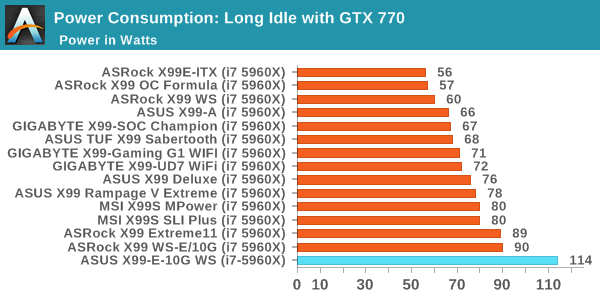

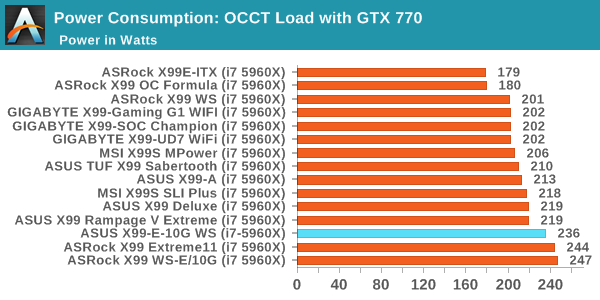
As was perhaps expected, the motherboards with the mode controllers end up drawing the most power. At idle and long idle, the X99-E-10G (at the wall) seems to consume a good portion of power, but during load the other big controller boards seem to draw more, making the CPU efficiency of the ASUS board quite good.
Non-UEFI POST Time
Different motherboards have different POST sequences before an operating system is initialized. A lot of this is dependent on the board itself, and POST boot time is determined by the controllers on board (and the sequence of how those extras are organized). As part of our testing, we look at the POST Boot Time using a stopwatch. This is the time from pressing the ON button on the computer to when Windows 7 starts loading. (We discount Windows loading as it is highly variable given Windows specific features.)

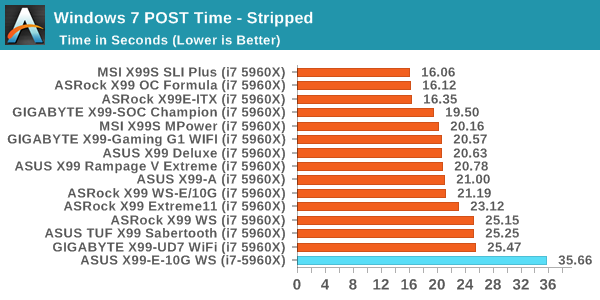
With extra controllers comes extra POST time, so moving nearer 50 seconds for a stock POST is not unexpected.
Rightmark Audio Analyzer 6.2.5
Rightmark:AA indicates how well the sound system is built and isolated from electrical interference (either internally or externally). For this test we connect the Line Out to the Line In using a short six inch 3.5mm to 3.5mm high-quality jack, turn the OS speaker volume to 100%, and run the Rightmark default test suite at 192 kHz, 24-bit. The OS is tuned to 192 kHz/24-bit input and output, and the Line-In volume is adjusted until we have the best RMAA value in the mini-pretest. We look specifically at the Dynamic Range of the audio codec used on board, as well as the Total Harmonic Distortion + Noise.
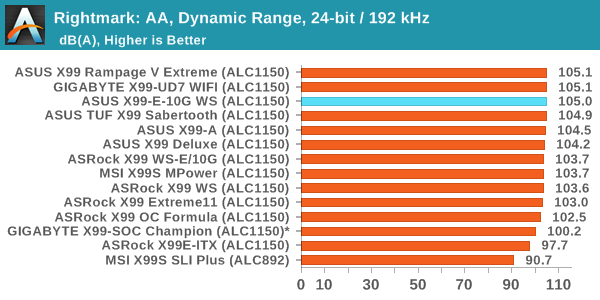
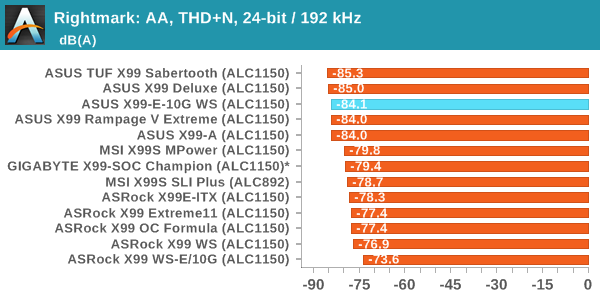
Despite audio not being a primary feature of the X99-E-10G WS, the performance (as with most ASUS boards) is in the top half of our testing and right ner the top. The fact that ASUS holds the top five spots in our X99 THD+N testing is rather impressive.
USB Backup
For this benchmark, we transfer a set size of files from the SSD to the USB drive using DiskBench, which monitors the time taken to transfer. The files transferred are a 1.52 GB set of 2867 files across 320 folders – 95% of these files are small typical website files, and the rest (90% of the size) are small 30 second HD videos. In an update to pre-Z87 testing, we also run MaxCPU to load up one of the threads during the test which improves general performance up to 15% by causing all the internal pathways to run at full speed.
Due to the introduction of USB 3.1, as of June 2015 we are adjusting our test to use a dual mSATA USB 3.1 Type-C device which should be capable of saturating both USB 3.0 and USB 3.1 connections. We still use the same data set as before, but now use the new device. Results are shown as seconds taken to complete the data transfer.
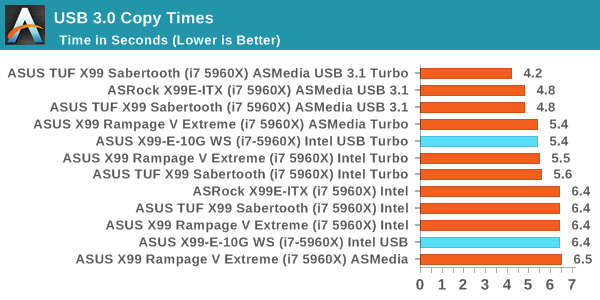

DPC Latency
Deferred Procedure Call latency is a way in which Windows handles interrupt servicing. In order to wait for a processor to acknowledge the request, the system will queue all interrupt requests by priority. Critical interrupts will be handled as soon as possible, whereas lesser priority requests such as audio will be further down the line. If the audio device requires data, it will have to wait until the request is processed before the buffer is filled.
If the device drivers of higher priority components in a system are poorly implemented, this can cause delays in request scheduling and process time. This can lead to an empty audio buffer and characteristic audible pauses, pops and clicks. The DPC latency checker measures how much time is taken processing DPCs from driver invocation. The lower the value will result in better audio transfer at smaller buffer sizes. Results are measured in microseconds.
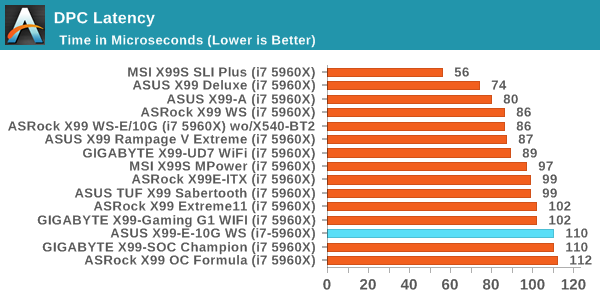
While a result of 110 is not the best X99 result, given the recent set of 250 microsecond results we've been seeing on the 100-series board, anything below that is pretty good.










63 Comments
View All Comments
karakarga - Wednesday, November 9, 2016 - link
If you connect a new modem or access point, having 5GHz or newest 60GHz, you need more than 150 megabytes, thus you need faster than 1Gigabit ethernet transfer speed....eek2121 - Wednesday, November 9, 2016 - link
Speak for yourself. Anyone in the photography or content creator will benefit from the faster speeds. Hell, even at my level I could use good 10 Gig hardware for the generation, transferring, storage, and streaming of 4K content across the network to/from a NAS, all while streaming my Blu-ray library to multiple locations in the house and playing a game at the same time.firefoxx04 - Tuesday, November 22, 2016 - link
Are you kidding me? Nobody? Not even someone buying a workstation board with 8+ core support and 16/16/16/16 PCIe support?I just added a 10Gbit fiber card to my desktop and my file server (raid5 with 4 drives) and im getting over twice as much throughput as I was before with no tuning to the driver. 112Mb/s network transfers feel slow now when my desktop is capable of 250-300Mb/s sustained. Hell, I even installed my entire steam library onto my network share because its simply fast enough (with no latency thanks to fiber optics).
But yeah, nobody could possibly benefit from 10G.
eSyr - Monday, November 7, 2016 - link
PCIe switch adds about 100—300ns to RTT, I don't think it would be critical for audio applications.nirsever - Tuesday, November 8, 2016 - link
Actually, there is a rather major shift towards 2.5G and 5G happening these days. It is driven primarily by:+ The recent ratification of the IEEE 802.3bz standard
+ Higher than 1G bandwidth demand of Wave2 11.ac WiFi APs coming up with 2.5G and 5G LAN ports
+ Availability of low cost and low power solutions from Tehuti Networks with PHYs from Marvell and Aquantia
BillR - Tuesday, November 8, 2016 - link
The rumor I heard is that extending a 1G PHY to work at 2.5G didn't add a lot to the price and power (about 30-50% in extra logic/power). Running at 5G my require a lot of the same logic used in a 10G PHY so a 5G solution would not offer huge power/cost advantages over 10G.nirsever - Wednesday, November 9, 2016 - link
I agree with your observation that cost wise, 5G and 10G are the same. However, from our experience, 5G power consumption is significantly lower than 10G. In addition, investing in 5G/2.5G capable NIC gives you the benefit of extending the life of your existing Cat5e/Cat6 cabling beyond 1G which is not possible with "classic" 10GBase-TBillR - Wednesday, November 9, 2016 - link
I agree.BrokenCrayons - Monday, November 7, 2016 - link
Just a thought...for a motherboard review, the feature image doesn't really show the motherboard or have a lot to do with the headline discussing networking.alamilla - Monday, November 7, 2016 - link
For an updated board it seems strange that they removed the Thunderbolt header with no options for Thunderbolt 3 expansion.Disappointing... :(